In a decision issued on March 18, 2011, a California Superior Court judge threw up a roadblock to the implementation of California’s cap-and-trade program by suspending the implementation of A.B. 32, the state’s landmark climate change law on the grounds that the California Air Resources Board (CARB) failed to properly consider alternatives to a cap-and-trade system.
In a decision issued on March 18, 2011, a California Superior Court judge threw up a roadblock to the implementation of California’s cap-and-trade program by suspending the implementation of A.B. 32, the state’s landmark climate change law on the grounds that the California Air Resources Board (CARB) failed to properly consider alternatives to a cap-and-trade system. While the Court upheld the validity of CARB’s Scoping Plan for implementing A.B. 32, thus saving CARB from having to revise the Scoping Plan, it found flaws with CARB’s environmental review of the Scoping Plan under the California Environmental Quality Act. As a result, not only has the proposed cap-and-trade program been put on hold, but at risk are other elements of the Scoping Plan, including the state’s low-carbon fuel standard and a 33% renewable portfolio standard for electricity by 2020. In his ruling, Judge Ernest Goldsmith of San Francisco Superior Court said that the CARB “seeks to create a fait accompli by premature establishment of a cap-and-trade program before alternatives can be exposed to public comment and properly evaluated.”
The ruling by Judge Goldsmith does not prohibit the CARB from adopting cap-and-trade or require the delay of the scheduled start of date of January 1, 2012, but Judge Goldsmith said that CARB must first analyze other options (such as a carbon tax) and explain why it did not choose such options. Given the tight timeline this year for finalizing the details of California’s climate change plan, the ruling represents a potentially significant hurdle in the timely implementation of the state’s greenhouse gas emission reduction initiatives. The CARB’s spokesperson, Stanley Young, expressed dismay at the scope of the ruling, which requires the board to conduct an environmental review and invite public comment before taking further steps to implement the law. Mr. Young has indicated that the CARB will appeal the decision, which could result in pushing back the cap-and-trade program’s January 1, 2012 start date. An alternative is for the CARB to seek a stay on the ruling that will allow it to implement the climate policies as planned until a final verdict is issued. Also, the CARB could complete the necessary analyses as quickly as possible, but the results of this approach would be uncertain. For example, if the CARB is unable to satisfy the court’s concerns by October 2011 – which is the key deadline for adopting cap-and-trade regulations – this would most likely put the January 1, 2012 start date at risk. If California’s cap-and-trade program is delayed, it is likely that other WCI jurisdictions such as B.C., Ontario and Québec, will also delay the implementation of their cap-and-trade programs until such time as California begins trading.
A.B. 32 was passed in 2006 and requires the state to reduce greenhouse gas emissions to 1990 levels by 2020. The legal challenge to California’s cap-and-trade program was brought by environmental justice groups (the Association of Irritated Residents and other groups) that consider the plan too weak. In particular, they argued that the cap-and-trade program would result in increased pollutants in poor and non-white communities. More mainstream environmental groups, however, have supported cap-and-trade and stayed out of the legal action.
The next likely step is that a Writ of Mandate will be filed within 10 days of the March 18 decision. The Writ is the plaintiffs’ interpretation of the decision and will include their preferred remedies. The judge will then decide on the final remedy. Any appeal to that decision would have to be filed within 60 days from the date the decision was entered.
At this stage, it is unclear what the court-ordered remedy will consist of and whether it will affect all work on measures to reduce greenhouse gas pollution – observers indicate that it most likely it will not. Following the decision, the Environmental Defense Fund issued a conciliatory statement that perhaps best captures the intent of the parties: “It is clear from examining arguments of both parties before the Court that CARB and the environmental justice groups bringing the action against the State are committed to improving California’s environment and fighting climate change and do not intend to bring AB 32 work to a halt.” Stay tuned as this story evolves.
